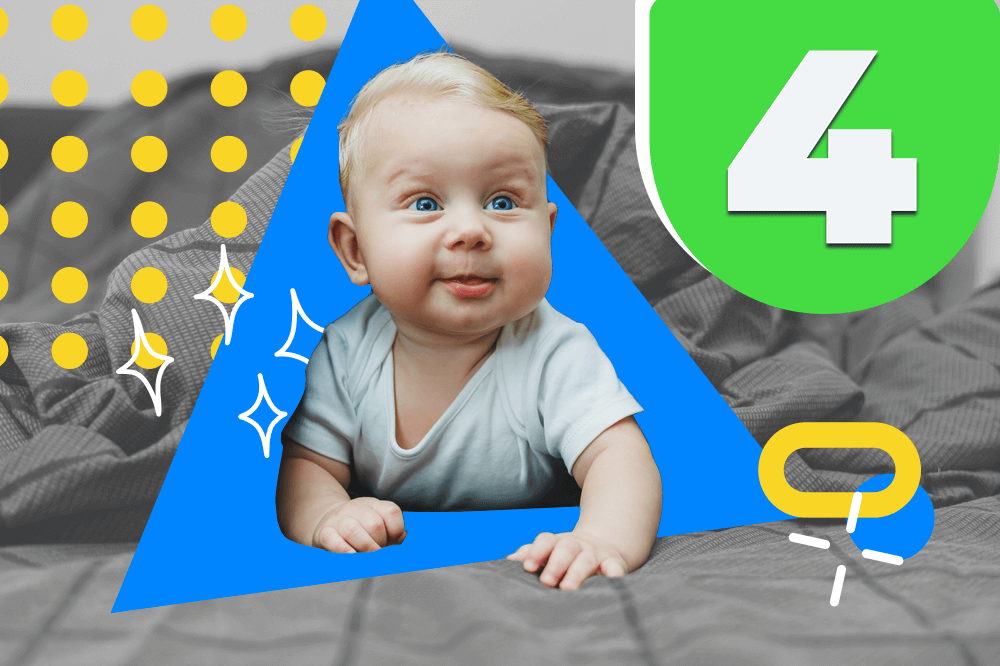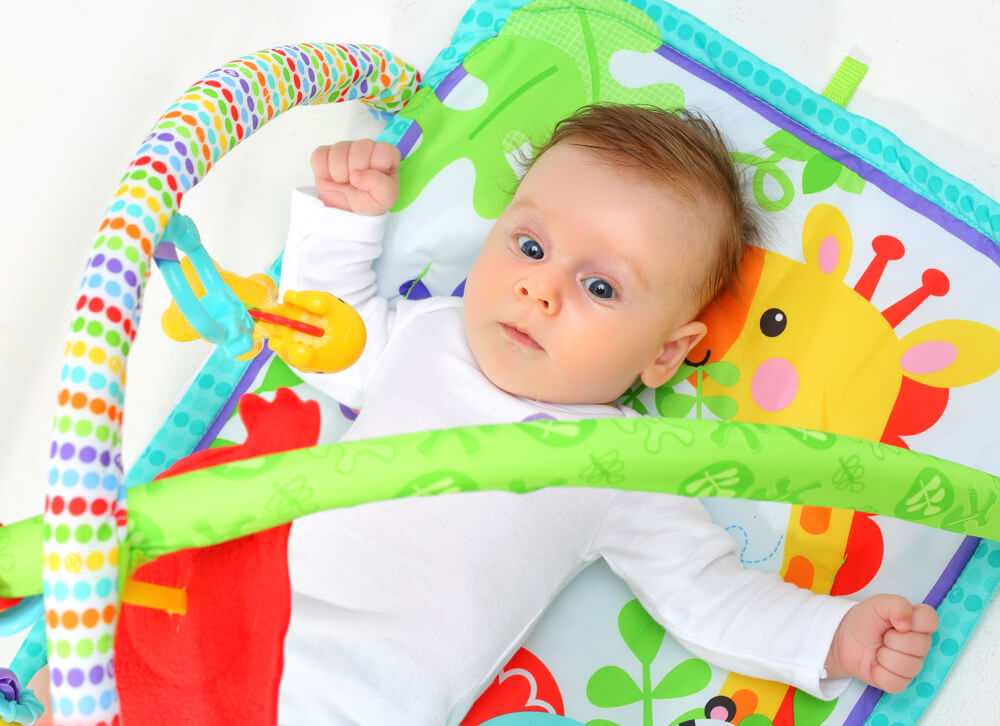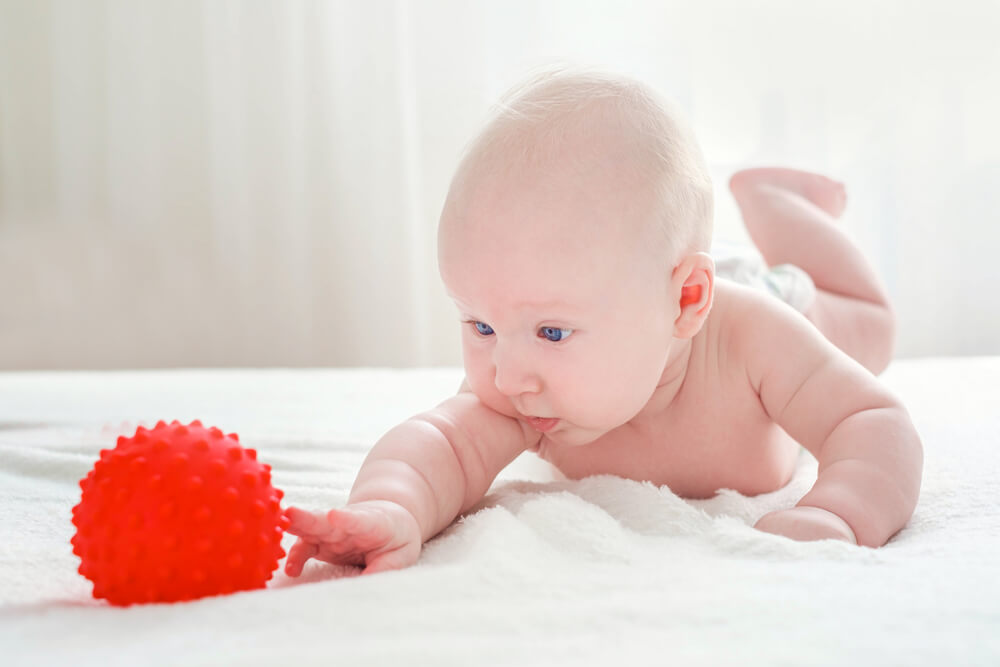4-Month-Old Baby Milestones: What Parents Can Expect

Parents compare the development of 4-month-old milestones of their baby against recognized standards. Any deviations from the standard behavior of a baby, especially a firstborn, are noticed immediately and categorized as “good” and “bad.” Before running to the pediatrician, you should recognize what is considered to be the norm, what the child simply does not know how to do yet, and the indicators that you really need to worry about.
Contents:
- 4-Month-Old Baby Physical Development
- What Should a 4-Month-Old Baby Be Doing?
- Doctor’s Opinion
- Deviations From the Norm That Should Raise Concerns
- How to Support a Child’s Development?
- FAQs
4-Month-Old Baby Physical Development

Arakelyan Andrey/Shutterstock.com
Tracking the development of your baby and making sure they meet their monthly milestones is just one responsibility new parents have. Ensuring they meet key milestones will keep your mind at ease, but it is also a sign to catch potential issues early.
Physical Abilities
The baby turns over onto or from their stomach, onto their back, independently or with the support of an adult. They start feeling everything that comes into their hands, and if there is nothing around, they lick their fingers, try to reach their leg with their mouth, or bite their fists. New physical abilities enter into action, allowing the hypertonicity of the legs to disappear. They swing them around actively and try to place the weight of their whole body onto their feet.
Active salivation, as an uncontrolled physiological process, becomes apparent, acting as a response of the immune system to the microbes that enter the body with objects that the baby starts to pull into their mouth.
The Difference Between Boys and Girls

Ekaterina Shtern/Shutterstock.com
Remember to take the gender difference into account. Girls are ahead of boys in their development in infancy. The norm is a gap of 4 weeks between the two genders. The weight and height of the children would also differ. So, a 5-month-old baby boy could be achieving the same milestones as a 4-month-old baby girl.
Physical development of a 4-month-old child:
| Indicators | Boys | Girls |
| Weight | 5,5-6,7 kg | 5,4-7,0 kg |
| Height | 58,7-64,5 cm | 58,4-64 cm |
| Head circumference | 41,5 – 42,5 cm | |
| Chest circumference | 43-44 cm | |
⠀⠀
Keep in mind that the mass index is calculated using a complex formula. Body mass index is the ratio of body weight in kg to length in the supine position or to the height in the standing position, in meters. If the baby is tall, they should weigh a lot, and vice versa. The weight is proportional to the baby’s height.
The child still spends most of the time in their crib or in the arms of their parents, allowing them to waste little energy, which is why they gain weight quickly. The average weight gain around 4 months old is 3 kg, and they grow by 10 cm from their day of birth.
What Should a 4-Month-Old Baby Be Doing?

margo_black/Shutterstock.com
Basic movements:
- turns over on the stomach;
- bends their arms at the elbows;
- stretches towards the object of interest with one hand;
- lifts their head and shoulders off the surface or grabs the fingers of an adult and tries to get up, while lying on their back;
- throws their head back in an attempt to examine objects in front of them, while lying on their stomach;
- can hold the ball with their feet or touch one foot with the other;
- reaches to the bottle or the breast of the mother for feeding.
The coordination of eye and hand movements is a priority milestone in the 4th month of the child’s life.
Reflexes

Alena Ozerova/Shutterstock.com
Reflexes that children gradually get rid of:
- Palmar Grasp Reflex — you’ll notice that your baby will try to grab things, especially if you put your finger in the palm of their hands;
- protective — if you put the child on their stomach, they will reflexively turn their head in order not to suffocate. This reflex is replaced by holding the head over time;
- searching — it becomes particularly noticeable 30 minutes prior to feeding. When pressing on the middle of the baby’s lip, their mouth opens in search of a nipple or bottle. This reflex then develops into the skill of opening the mouth when a spoon is brought up near it, over time;
- proboscis reflex — the lips of the child get into the shape of a ‘tube’ in a reaction to a light blow with on them with the fingers;
- palmar-oral reflex — when pressing the thumbs on the hand, the child turns their head towards it and opens their mouth. It may be slightly alarming if this reflex does not disappear by the age of 4 months. In this case, it is better to visit a neurologist, as this can be a signal of a delay in speech development or a sign of nervous system damage.
Each disappearing reflex is replaced with a new skill, a more complex reaction, and a behavioral pattern. The stepping reflex may still be present, as the baby tries to stand on their feet when held in an upright or slightly tilted position. The Moro reflex manifests itself when they hear a sharp sound or a blow on the surface near them. Both of these reflexes may remain partially or entirely absent. In either case, this is not considered a deviation from the norm.
Intellectual Development

Natalia Lebedinskaia/Shutterstock.com
When the first trimester of life is over, the baby begins to take an active interest in the surrounding objects and develop cognitive skills. Foster this interest by taking your child on a “tour” around the house. Show them things and let them hold various objects while pronouncing their names. Flip through some books with large images. While the child’s hearing ear is actively developing, sing some songs quietly or tell some stories to your baby.
The research conducted by the WHO in 2019, recommends the following in order to ensure the psychological well-being of the baby:
- engaging in a variety of physical activities, such as playing on the floor and interacting with adults;
- not laying immobile for more than 1 hour in a row while being awake (in strollers, children’s loungers, and car seats);
- not spending any time in front of the screens, and replacing it with face-to-face communication with adults;
- 12-16 hours of quality healthy sleep, comprised of nighttime + daytime sleep.
Sticking to these recommendations will allow you to raise a psychologically and intellectually healthy child.
Psycho-Emotional State

Tomsickova Tatyana/Shutterstock.com
At the age of 4 months old, the child begins to navigate in space more efficiently and to recognize familiar faces around them. When seeing their loved ones, they smile and move their arms and legs actively while making incoherent sounds to express their joy. They can already determine who their mother is. Parents can also start hearing individual sounds and short syllables that are vaguely similar to the child naming their parents, such as “ma” or “mama”. Of course, they still do not say “mother”; however, their parents can already start distinguishing the first foundations to full words.
The baby expresses their emotions vividly with their current communication skills, allowing the parent to distinguish them. It is immediately visible when a child is happy, angry, or afraid of something. During the day, they actively display an interest in their hands and feet and freeze for a second when someone says their name. The 4-month-old baby also feels the music and turns towards the side where the voice or the sound is coming from.
By 4 months old, the baby’s vision becomes similar to an adult’s. The child starts distinguishing between red, blue, and yellow colors; however, there is no need to tire their eyes and nervous system with colorful toys.
Sleep, Food, and Daily Timetable

LeManna/Shutterstock.com
At the age of 4 months, the child is still being breastfed, and if it is not possible, they are formula-fed with the addition of very small portions of vegetable puree or porridge. The addition of more solid foods should be done as prescribed by the pediatrician and with no more than 1 teaspoon of puree per day. Portions of these foods are increased on a daily basis, going up to 100 grams per day.
The frequency of meals becomes gradually reduced. What is now sufficient is a five-times-a-day breastfeeding schedule, with the last one taking place at 8 pm or 9 pm, or formula feeding six times a day with an interval of 3-3.5 hours between meals. After the evening meal, the baby sleeps peacefully until 10 o’clock.
Children gradually move towards organizing a new eating schedule. The transition period can take up to 5-6 months. At this time, they wake up at night to eat. Don’t ignore their needs, but instead of breast milk or formula, give them some special tea for infants or some diluted juice. Over time, they will get used to the new feeding schedule and sleep until the morning.
The four-month-old child needs to be taught when it is time to be awake and when they should be sleeping. At this age, you need to adhere to a defined daily schedule for sleep. However, you do not need to follow the schedule by the minute; it is enough to repeat the same sequence of actions every day.

Rafal Olechowski/Shutterstock.com
The baby needs to do the following daily:
- be outdoors for at least 3-4 hours a day during summer and for 1-2 hours in winter. Walks strengthen the immune system and allow the child to explore the world around them;
- hear the voice of parents reciting short rhymes or singing songs;
- play with several rattles, differing in shape, color and sound;
- do gymnastics after walking or at lunchtime;
- take baths with herbal extracts or sea salt. Any supplements must be administered with the permission of a physician.
Try roughly sticking to the following daily timetable:
| Time | Activity |
| 7:00 | Wake up and feeding |
| 7:30 | Playtime in bed |
| 8:00 | Nap |
| 9:30 | Feeding and being awake |
| 10:30 | Outside walk and possible sleep |
| 12:00 | Feeding and gymnastics |
| 14:00 | Outside walk with a nap |
| 16:00 | Feeding, playing with adults and listening to music |
| 18:00 | Afternoon nap |
| 19:00 | Calm games and interaction with adults |
| 20:00 | Feeding, bath, and preparation for bed |
| 21:00 | Nighttime sleep |
| 01:00 | A drink of infant tea or diluted juice (preferably sugar-free), if needed |
⠀
Although you can teach your baby to adhere to the daily routine, their nutrition and sleep will depend on their physiology. Children who are born prematurely or on time but with a large weight may be slightly behind their peers.
Doctor’s Opinion

Microgen/Shutterstock.com
Doctors recommend playing with the child and talking to them more while changing the intonation, volume, and tempo of speech. This will further help in developing language skills and emotional milestones later on. They are already beginning to become aware of themselves among others and to recognize their mother’s voice. Play some music and let the baby play with musical toys. Encourage your toddler if they display interest in things around them. Here is a video on how to encourage the child to play and how to develop your baby’s brain:
Deviations From the Norm That Should Raise Concerns
The emergence of new reflexes and skills in children occurs individually and surely not in strict accordance with the schedule mentioned in this article. You need to worry if they do not appear in 1.5–2 months after reaching the 4-month milestone.
Pay attention to the following factors:
- the child has no willingness to move; they are lying down and not turning to the side the majority of the time;
- they cannot hold their head;
- instead of humming, the baby continues screaming with short periods of silence;
- the baby does not pay attention to the appearance of new sounds or music;
- they do not show any emotion at the sight of the mother or her voice;
- a smile appears on their face rarely and rather arbitrarily, without a particular reason;
- the baby displays no interest in surrounding objects or in their body.
Deviations from the norm can be noticed by relatives or a pediatrician during a routine examination. If your toddler cannot do what they should be able to do at this age, consult a doctor who will refer you to a neurologist for a consultation.
How to Support a Child’s Development?

DinaPhoto/Shutterstock.com
Find out what your baby should be able to do at the 4-month milestone and help them develop emerging skills. During games, even if they are trying to get up as if they were doing crunches, do not let them sit, as their weak spine will have an excessively large load placed on it.
Moreover, girls are also strictly prohibited from sitting at this age, due to the risk of improper uterus laying, which subsequently leads to problems with conception and childbirth. A purposeful desire to sit down is formed by the age of 5 months. Before that, give your baby some muscle-strengthening massages.
The age of 4 months allows one to develop the following:
- fine motor skills;
- movement coordination;
- visual memory;
- concentration;
- speech.
The time the child is awake increases, and it can be spent on games together.
Movement coordination can be developed with the help of balls or rattles hanging over the child’s bed. They should hang low enough so that the baby can kick them when lifting their legs. If it is impossible to hang them, put a toy or a ball on the bed.

veet/Shutterstock.com
By developing the child’s hearing and attention, you can simultaneously satisfy their need to feel everything around them. Let your baby play with keyboard musical instruments. A toy piano that makes different sounds by pressing the keys will give them a lot of joy. This game will teach the child to associate a sound with finger movements.
Use objects of different shapes and textures to develop the child’s fine motor skills:
- Take some small cubes or balls. Place them under the handles, making sure that their fingers clasp the entire surface of the object.
- Give your baby smooth, rough, soft, hard, fluffy, and slightly prickly objects. Take a look around yourself – you are surrounded by these items. Buy tactile pouches from the store, or make your own by filling a fabric pouch with buckwheat, beans, peas, and other grains. They can be used during games and massages.
The developed skill of recognizing sounds can be reinforced through repetition. Attract the baby’s attention by ringing the bell and then by verbally repeating the sound. This will lay the foundation for the child’s pronunciation of sounds and syllables.
Parents need to know what a 4-month-old baby should be able to do in order to react quickly if a delay in their development can be spotted. While it is too early to panic one day after the child turns 5 months old, when this exceeds the milestone of six months, it is surely the time to be alarmed.
FAQs

Ramonki/Shutterstock.com
What development should a 4-month-old baby be doing?
Your baby’s four-month milestones include better control of their neck and head movements, rolling over, reaching for objects, babbling and cooing, and recognizing familiar faces.
How smart is a 4-month-old baby?
The cognitive abilities of a 4-month-old develop rapidly in this stage. They are able to track items visually, pay attention to people and objects, be aware of cause and effect, and begin to develop memories.
What should I look for in a 4-month-old baby?
The main milestones to look for in your four-month-old baby are improved head and neck control, paying attention to objects, recognizing their mother’s face, and starting to babble or coo.
What do 4.5-month-old babies do?
At around four and a half months, babies should show improved motor skills, increased social and emotional interaction, take in sounds, and begin exploring the world more. These developments will take place over different periods of time, but mostly during the fourth month.
The Next Stage of Your Child’s Development
The fifth month of your child’s development is just around the corner! We have prepared a detailed guide for this stage of development too: click and read. Or bookmark the section with the child’s age development calendar from 1 month to 14 years and come back to it at any convenient time!
Проверьте электронный ящик



















